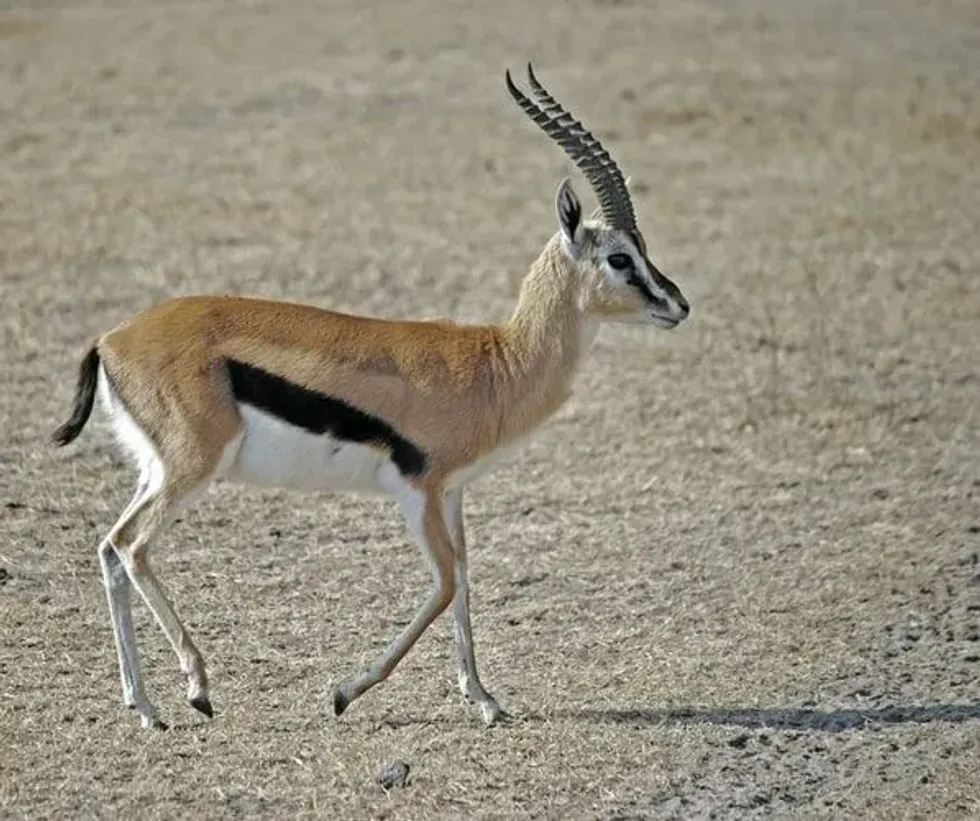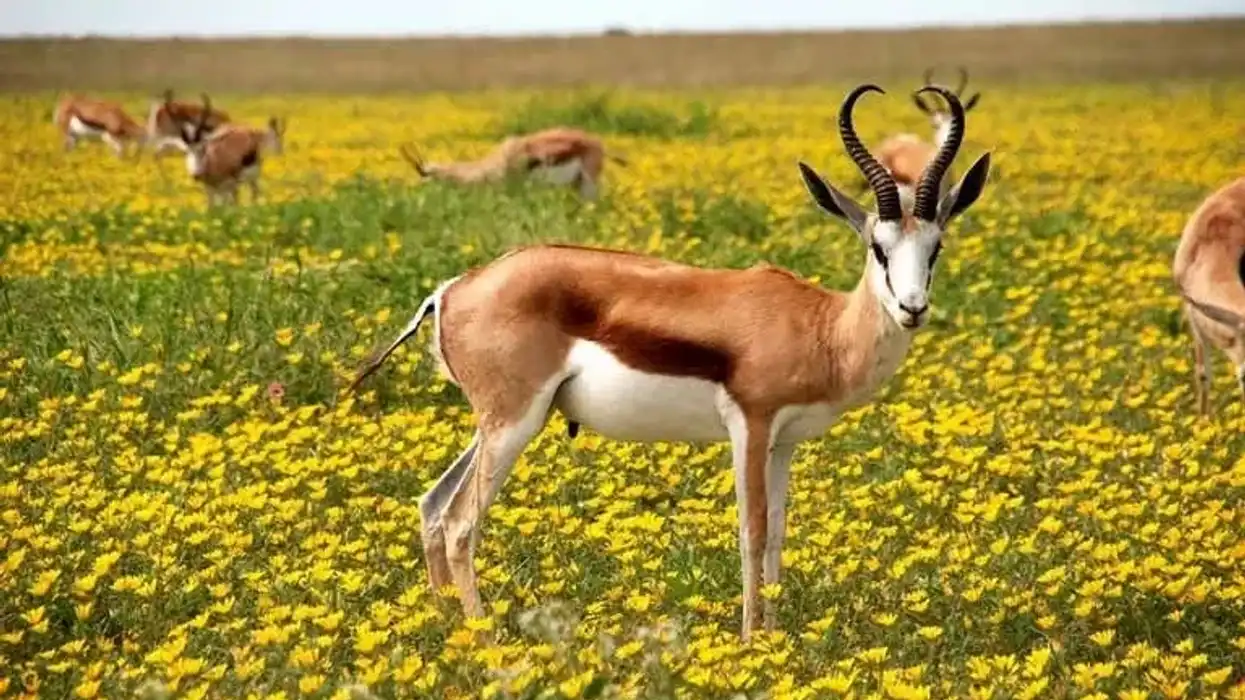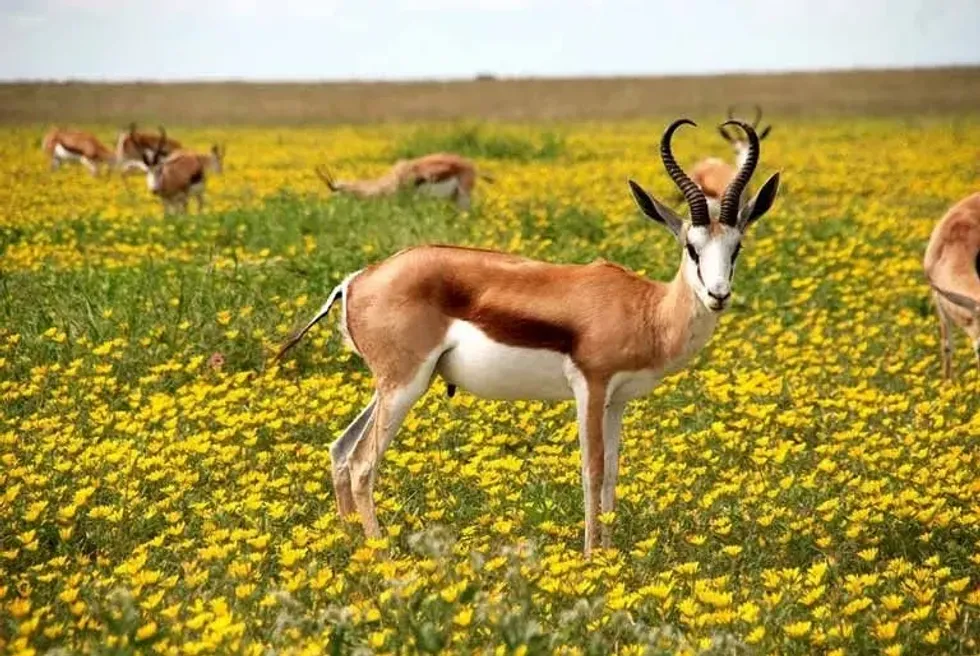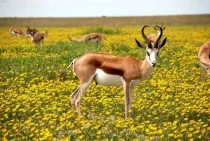Fun Antelope Facts For Kids

Content
- What type of animal is an Antelope?
- What class of animal does an Antelope belong to?
- How many Antelopes are there in the world?
- Where does an Antelope live?
- What is an Antelope's habitat?
- Who do Antelopes live with?
- How long does an Antelope live?
- How do they reproduce?
- What is their conservation status?
- What do Antelopes look like?
- How cute are they?
- How do they communicate?
- How big is an Antelope?
- How fast can an Antelope move?
- How much does an Antelope weigh?
- What are their male and female names of the species?
- What would you call a baby Antelope?
- What do they eat?
- Are they dangerous?
- Would they make a good pet?
- Did you know...
- Why are some kinds of Antelopes endangered?
- Different adaptations of different types of Antelopes
Watching these animals on television, leap and jump across open spaces has always been fascinating.
Striding around the open grasslands with long, powerful legs and firm hooves. Looking up valiantly with its slender neck, and big horns standing upright.
The antelope has always been a symbol of beauty and grace. Antelopes are common herbivores that are usually found in forests and savannas. Most of the antelopes are native to the vibrant African lands.
However, you will find some of them in Asia and the Middle East as well. 91 different species come under the Bovids antelope family, and these species occur in 30 different genera.
Antelopes are often confused with cervids such as deer, moose and elk. The main difference between bovids and cervids is that cervids possess antlers which are often shed, whereas bovids grow long permanent horns.
Impalas, lechwes, oryxes, gnus, and gazelles all come under the antelope family.
Fascinated by learning about the antelope? You will definitely have a good time reading our pages on the South China tiger and the collared peccary.
Antelope Interesting Facts
What type of animal is an Antelope?
Antelopes are a wide variety of mammals that have horns and hooves and come under the family Bovidae.
What class of animal does an Antelope belong to?
The antelopes belongs to the class Mammalia.
How many Antelopes are there in the world?
There is no exact record of the total number of individuals in this species. However, we know that there are 91 species under the antelope family.
Where does an Antelope live?
Antelopes live in highland areas, arid bushy regions, rainforests, and even grasslands.
What is an Antelope's habitat?
A majority of the antelope species live in large open grasslands. As well as this, a few of them live in woody areas or tropical rainforests. These include the royal antelope, duikers, and the sunis.
Another antelope species, dik-diks, prefer an environment with good lush vegetation.
The mountain sunis prefer the highland forests of Africa.
The lechwe and waterbuck are usually situated near a freshwater source.
Who do Antelopes live with?
Antelopes usually prefer living in groups, which are called 'herds'.
How long does an Antelope live?
The antelope lifespan varies according to the antelope species. A few species may live only for three years, while some can survive for up to 28 years!
How do they reproduce?
Different antelopes have different approaches to breeding.
Some antelope members have a lek breeding ritual. Lechwes usually follow this trend. The male antelopes usually meet up on a leaking sight and thus start a competition for their personal territories. The female antelopes observe the fights and choose their partners.
Large antelopes form big herds that have only one mating buck, but many other breeding females. No other buck is included in this group as they are usually defeated in combat to become the alpha. These competitions usually take place every season to grab the alpha position and breed with the bucks. Wildebeests and impalas also follow this approach.
Smaller species, such as the dik-diks, follow monogamy. These animals usually live in patchy forests, and hence usually have only one partner due to the sparse vegetation available.
The buck has a pregnancy that lasts up to nine months. Usually, her litter has only one calf, but there might be instances where twins are born. These little babies are vulnerable to predators and usually different resorts are taken to take care of the calves.
Usually, the calves are safely hidden from predators, and their parents return to the herds or hunt for food. There may be instances where the calves are relocated many times to hide them from larger animals. Alternatively, the calves are urged to join the herds immediately and travel with the group. The other adult antelopes protect the younger ones.
Their ages of maturity vary between six months to eight years.
What is their conservation status?
The entire antelope population is safe. However, many species under the antelope family are endangered.
Antelope Fun Facts
What do Antelopes look like?

When you first think of an antelope, you can see the elegant legs running fast in the wild. Antelopes have slender, long and strong legs - these help them in running fast and covering more ground in each stride.
Antelopes, such as the gerenuks and dibatags, have such strong hind legs that they can stand on them and reach the food on tall trees. Gazelles and springboks can leap great heights and run really fast too.
A beautiful dense furred pelage covers these beautiful species. Usually, their coats are in various multiple hues of brown.
They also have pale white or beige underbodies. Some exceptions include the zebra-duiker who have multiple stripes on their backs, or the black lechwe, or even the Jentink's duiker which has multiple tints of black, white, brown and grey.
The Arabian oryx is a proud owner of a silvery-white fur coat, and the southern oryx and beisa sport a grey-black pelage.
Antelopes have strong molars which helps them chew on the cud and crush down the grass. This species does not have upper incisors; instead they have a strong upper gum pad which works together with its lower incisors to chew on food.
The eyes of antelopes are placed in such a way that they have can cover a broader area in sight. They also have sharp sense of hearing and smell.
In almost every antelope species, both the males and females have horns, though the males have bigger ones. Males usually have bigger bodies in most of the species. The horns of some species are straight and point upwards, whereas some have spiraled horns. These horns are covered with a thick sheath. Some species have ridges in their horns.
How cute are they?
These big horned species are actually pretty adorable to look at!
How do they communicate?
The bodily marks on the heads, rumps, legs, and ears of this mammal are sometimes used for communication. This species also uses bodily scents to define their lands. This scent might also be used to maintain contact with their fellow members of the species.
Vocal communication of an antelope includes whistles, trumpets, barks, and moos.
The Maxwell’s duikers have various alarm calls. They have an alarm whistle as well a loud bleat to alert their fellow duikers. Some antelopes make cough-like grunting noises in case of any threats. Certain members of the antelope family like the klipspringer make shrill whistling sounds.
Gerenuk calls are a combination of a moan and a grunt. Squeaky calls convey their annoyance or irritation, whereas a generuk’s buzz is a sign of alarm.
The gnu actually got its name by the ‘ge-nu’ sound it makes. Some antelope types also ‘bark’ to alert their herds. The antelope which wants to assert dominance might also let out low-frequency sounds to show its alpha status.
How big is an Antelope?
The Neotragus pygmaeus, also known as the royal antelope, are the smallest of all antelopes. They are only about 10 in (25 cm) tall at their shoulders. The length of this antelope from the head to the body is about 16 in (40 cm).
The Taurotragus derbianus, popularly known as the giant eland, is the largest antelope species. They stand as tall as 4.3-5.9 ft(1.3-1.8 m). This species usually has a head-to-body length of about 7.2-9.5 ft(2.19-2.9 m). Their tails are about 35 in (89 cm) long.
The royal antelope is as big as a wild hare-easy to scoop in your arms! Coming to the giant eland, this animal is as big as an adult horse!
How fast can an Antelope move?
The fastest of all antelopes is the pronghorn antelope, also known as the American antelope. This antelope is the second fastest of all land animals, and can even out-sprint some of its predators. They can attain speeds of up to 56 mph (90 kph)!
How much does an Antelope weigh?
The royal antelope, the smallest among the antelopes, weighs only about 5.5-6.5 lb (2.5-3 kg). The largest among the antelope clan, the giant eland, has varied body masses for the two genders. The male antelope weighs about 880-2200 lb (400-1000 kg), whereas the female ones weigh about 660-1350 lb (300-615 kg).
What are their male and female names of the species?
The female antelope is called a 'doe', whereas the male ones are referred to as a 'buck'.
What would you call a baby Antelope?
Antelope babies are called 'calves'.
What do they eat?
The antelope's diet is mainly herbivory. Almost every species under the antelope is a pure vegetarian, except the duiker. Duikers are small to medium-sized antelopes who stay in the forests. Duikers supplement their meals with little meat of birds, small insects, and smaller mammals.
Antelopes generally have two different strategies for food - browsing and grazing.
The browsers mainly eat seeds, fruits, leaves, bark, and flowers, all of which are close to the ground. The grazer antelopes eat grass and vegetation similar to grass.
Some types of antelopes, such as the dibatags and gerenuks, have strong hind legs which help them stand solely on them and grab the leaves from tall trees.
The antelope is a smart animal, known to follow monkeys, zebras, and other animals to search good grounds for food and grass.
Are they dangerous?
Antelopes prefer to stay away from other animals. However, if you get too close and try to approach them, they might attack you with their strong legs.
Would they make a good pet?
We do not think all antelopes would make good pets, as earlier efforts of taming this species have proven to be futile. However, smaller antelopes would make cute pets. Taking care of the antelope is really critical.
Did you know...
Researchers have found that the Hirola is the rarest of all antelopes in the world. Fewer than 500 Hirola individuals are said to be remaining in the world today. A disease called rinderpest wiped off almost 80% of the hirola population almost 50 years ago.
Adding to these facts, the name ‘antelope’ comes from ‘antholops’, a Greek term. Antholops is formed from its elements ‘anthos’, which means ‘a flower’, and ‘ops’, translating to ‘eye’, thus meaning ‘beautiful eye’.
This horned mammal has horizontal pupils.
Antelope adaptations can be observed in their even-toed hooves - those living in flatlands have flat hooves, while those who can climb have suction-like hooves. These hooves also help them to run and escape from predators.
Why are some kinds of Antelopes endangered?
The IUCN has listed about 25 species and many subspecies of the antelope under the ‘Endangered’ category. Some of the animals who are endangered include the mhorr gazelle, dama gazelle, giant sable antelope and the mountain nyala.
Some of the main reasons these animals are under the endangered category are competition for forage with other cattle, habitat destruction, and hunting.
Saigas are usually poached for their horns. Only the male saiga antelope possesses horns, and hence they are hunted in large numbers. Their wax-coloured horns are used in Chinese medicines and have other purposes as well. Unfortunately, the saigas are listed as critically endangered animals.
The fur of the Tibetan antelope is famous for its shahtoosh wool and hence gets poached for its pelt. This wool is usually opted for making shawls and coats. Fur of this kind can unfortunately be removed only from the dead antelopes.
But each antelope gives only a small amount of downy fur. To make a proper piece of apparel, many antelope need to be killed. This demand has been leading to a constant decline in the population of Tibetan antelope.
Apart from horns and fur, these animals are also hunted for their meat. Some people hunt antelopes for fun.
Other than human poaching, you might always spotted the antelope being a common prey for wild predators such as lions, hyenas, cheetahs and other large carnivorous birds.
Different adaptations of different types of Antelopes
Antelopes are widely divided into many subgroups. Some of these groups are Aepycerotinae, Antilopinae, Cephalophinae, Hippotraginae, Pantholopinae, Peleinae, Reduncinae, and Tragelaphini.
The Antilopinae are considered as the truest of all antelopes. The majority of the animals of the Bovidae family come under the Antilopinae. This includes dibatags, springboks, gazelles, and even blackbucks. These bovids are found throughout Africa and Asia. Antelopes, both of small and medium size, belonging to this family are found in Africa.
The Reduncinae group prefers habitats that are closer to water sources. They live in marshes, floodplains, and wetlands. Only three genera come under this clan - Redunca (the reedbucks), Kobus (the waterbucks) as well as Pelea (rhebok). These antelopes have beautiful hair, and the strong horns are possessed only by the males.
The Hippotraginae group includes animals with large bodies, powerful legs, and thick necks. Many grazing antelopes such as the sable antelope, roan antelope as well as oryxes, are a part of this group. These animals live in arid lands. They have erect manes running down their necks and are found in Asia and Africa.
The Cephalophinae subfamily are also known as duikers, and include the forested antelopes. Duikers live mainly in the tropical regions of Africa and 18 species of duikers are in this family. Females of this group are slightly bigger than the bucks. They primarily eat fruits.
The Alcelaphinae group have other large antelopes such as the bontenoks, hartebeests and wildebeests. This group is native to the African lands and are mainly grazers. Members of this type, both the males and females, have strong double curved horns.
The Caprinae group includes muskox, sheep, and goats. These antelopes are often found mainly in alpine and montane habitats. The two genders of this group posses horns.
The Aepycerotinae are native only to Africa. Only one species falls in this subfamily - the impala. Only male impalas are proud owners of horns.
Here at Kidadl, we have carefully created lots of interesting family-friendly animal facts for everyone to discover! Learn more about some other mammals including the African civet and the black-footed ferret.
You can even occupy yourself at home by drawing one of our antelope coloring pages.
We Want Your Photos!
More for You
See All
Bachelor of Science specializing in Mass Communication.

Adekunle Olanrewaju JasonBachelor of Science specializing in Mass Communication.
Bachelor of Commerce

Shikha SharmaBachelor of Commerce
Shikha has a Bachelor of Commerce degree from the University of Delhi. She also holds a Diploma in Information Technology, which has helped her acquire technical and design skills.
Disclaimer
1) Kidadl is independent and to make our service free to you the reader we are supported by advertising. We hope you love our recommendations for products and services! What we suggest is selected independently by the Kidadl team. If you purchase using the Buy Now button we may earn a small commission. This does not influence our choices. Prices are correct and items are available at the time the article was published but we cannot guarantee that on the time of reading. Please note that Kidadl is a participant in the Amazon Services LLC Associates Program, an affiliate advertising program designed to provide a means for sites to earn advertising fees by advertising and linking to Amazon. We also link to other websites, but are not responsible for their content.
2) At Kidadl, we strive to recommend the very best activities and events. We will always aim to give you accurate information at the date of publication - however, information does change, so it’s important you do your own research, double-check and make the decision that is right for your family. We recognise that not all activities and ideas are appropriate for all children and families or in all circumstances. Our recommended activities are based on age but these are a guide. We recommend that these ideas are used as inspiration, that ideas are undertaken with appropriate adult supervision, and that each adult uses their own discretion and knowledge of their children to consider the safety and suitability. Kidadl cannot accept liability for the execution of these ideas, and parental supervision is advised at all times, as safety is paramount. Anyone using the information provided by Kidadl does so at their own risk and we can not accept liability if things go wrong.
3) Because we are an educational resource, we have quotes and facts about a range of historical and modern figures. We do not endorse the actions of or rhetoric of all the people included in these collections, but we think they are important for growing minds to learn about under the guidance of parents or guardians.







